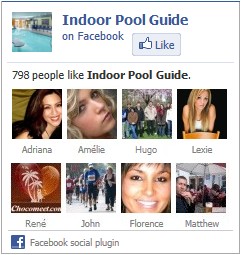
Three basic circulation designs for a traditionally shaped pool tank. Each has advantages and disadvantages, and careful consideration must be given before choosing the appropriate option and building a pool; changes are often not possible once a pool has been built. Each option is discussed below.
Floor Inlet, Surface Outlet
This common arrangement offers good circulation. However, it can be a long distance between the supply and return, where circulation dead spots can occur. Skimmers usually run around the whole pool, providing consistent recovery of soiled water. A recent improvement has been to introduce a second row of supply outlets along the pool, improving circulation to all points. However this also increases construction costs.
Side Inlet, Surface Outlet
Filtered water is supplied through the wall at one end of the pool, and taken from the opposing or adjacent edge (skimmer), which often does not go around the whole pool. This can lead to large dead spots in the area furthest from the supply and scum lines on walls without skimmers.
Combination Inlet, Surface Outlet
Supply water enters the tank from both the floor and the walls, in a strategic combination aimed at minimising dead spots. This is by far the most effective method of circulation, often used in less regularly shaped pools—however it is also the most expensive.
Floor returns can also be used to return water to the treatment plant. These are often located at the deepest part of the pool tank, and double as drains to allow for maintenance of the tank itself.
Valves can be installed to control the amount of supply and return water where there is a particular need, such as for pools with variable depth floors, moveable bulkheads, or other changes which might affect circulation.
It is recommended that pool tests be periodically undertaken at several locations (at the same time) to provide the operator with some knowledge about the circulation patterns occurring within the pool. A higher concentration in one area than another may indicate either a lower bather load, or a lower flow of treated water to that point.
Multiple Pools in a Complex
It is increasingly common for facilities to offer a combination of pools, each with a separate filtration plant.
Older facilities often have multiple pools operating with only one filtration plant. A single system for two or more pools is quite common. Care should be taken to ensure the hydraulics, chemical monitoring and dosing are properly designed and managed in each pool, not in the overall plant.

